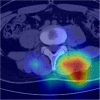Vision transformer-based diagnosis of lumbar disc herniation with grad-CAM interpretability in CT imaging
- PMID: 40301802
- PMCID: PMC12039304
- DOI: 10.1186/s12891-025-08602-2
Vision transformer-based diagnosis of lumbar disc herniation with grad-CAM interpretability in CT imaging
Abstract
Background: In this study, a computed tomography (CT)-vision transformer (ViT) framework for diagnosing lumbar disc herniation (LDH) was proposed for the first time by taking advantage of the multidirectional advantages of CT and a ViT.
Methods: The proposed ViT model was trained and validated on a dataset consisting of 983 patients, including 2100 CT images. We compared the performance of the ViT model with that of several convolutional neural networks (CNNs), including ResNet18, ResNet50, LeNet, AlexNet, and VGG16, across two primary tasks: vertebra localization and disc abnormality classification.
Results: The integration of a ViT with CT imaging allowed the constructed model to capture the complex spatial relationships and global dependencies within scans, outperforming CNN models and achieving accuracies of 97.13% and 93.63% in terms of vertebra localization and disc abnormality classification, respectively. The performance of the model was further validated via gradient-weighted class activation mapping (Grad-CAM), providing interpretable insights into the regions of the CT scans that contributed to the model predictions.
Conclusion: This study demonstrated the potential of a ViT for diagnosing LDH using CT imaging. The results highlight the promising clinical applications of this approach, particularly for enhancing the diagnostic efficiency and transparency of medical AI systems.
Keywords: CT; Deep learning; Diagnostic accuracy; Grad-CAM; LDH; Medical imaging; ViT.
© 2025. The Author(s).
Conflict of interest statement
Declarations. Ethics approval and consent to participate: Our study adhered to the Declaration of Helsinki. This study received approval from the Ethics Committee of the First Affiliated Hospital of Anhui University of Traditional Chinese Medicine (no. 2024MCZQ28), and the ethics committee waived the need to consent to participate because of the minimal risk involved. Consent for publication: Not applicable. Competing interests: The authors declare no competing interests.
Figures











Similar articles
-
Enhanced tuberculosis detection using Vision Transformers and explainable AI with a Grad-CAM approach on chest X-rays.BMC Med Imaging. 2025 Mar 24;25(1):96. doi: 10.1186/s12880-025-01630-3. BMC Med Imaging. 2025. PMID: 40128729 Free PMC article.
-
Development and application of AI assisted automatic reconstruction of axial lumbar disc CT images and diagnosis of lumbar disc herniation.Eur J Radiol. 2025 Apr;185:112003. doi: 10.1016/j.ejrad.2025.112003. Epub 2025 Feb 13. Eur J Radiol. 2025. PMID: 39965414
-
Vision transformer and deep learning based weighted ensemble model for automated spine fracture type identification with GAN generated CT images.Sci Rep. 2025 Apr 25;15(1):14408. doi: 10.1038/s41598-025-98518-7. Sci Rep. 2025. PMID: 40274849 Free PMC article.
-
Deep learning algorithms to assist in imaging diagnosis in individuals with disc herniation or spondylolisthesis: A scoping review.Int J Med Inform. 2025 Sep;201:105933. doi: 10.1016/j.ijmedinf.2025.105933. Epub 2025 Apr 17. Int J Med Inform. 2025. PMID: 40252304
-
Lumbar discography followed by computed tomography. Refining the diagnosis of low-back pain.Spine (Phila Pa 1976). 1990 Jul;15(7):690-707. doi: 10.1097/00007632-199007000-00015. Spine (Phila Pa 1976). 1990. PMID: 2145643 Review.
References
-
- Knezevic NN, Candido KD, Vlaeyen JWS, Van Zundert J, Cohen SP. Low back pain. Lancet. 2021;398(10294):78–92. - PubMed
-
- Lee JH, Choi KH, Kang S, Kim DH, Kim DH, Kim BR, et al. Non-surgical treatments for patients with radicular pain from lumbosacral disc herniation. Spine J. 2019;19(9):1478–89. - PubMed
MeSH terms
Grants and funding
LinkOut - more resources
Full Text Sources
Medical

